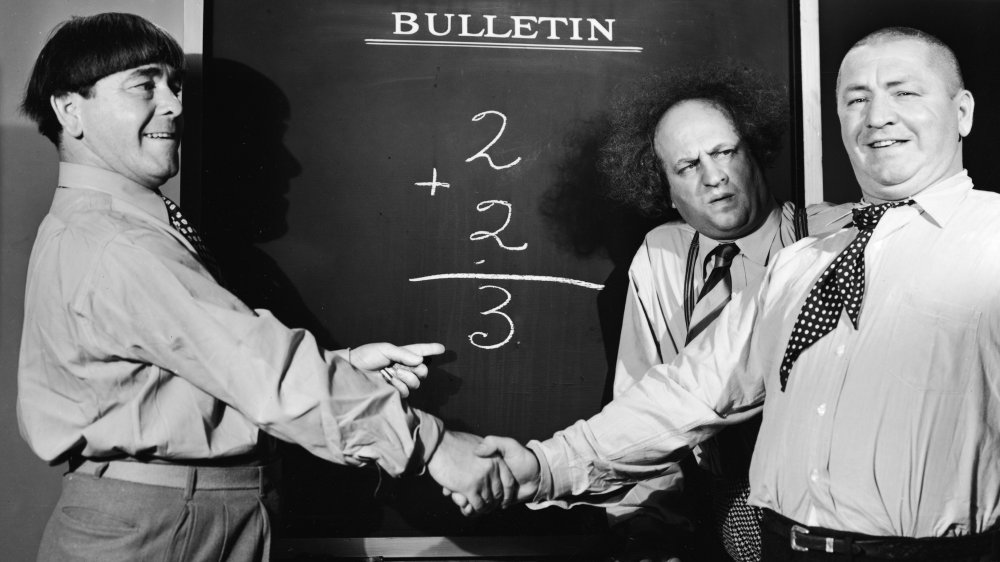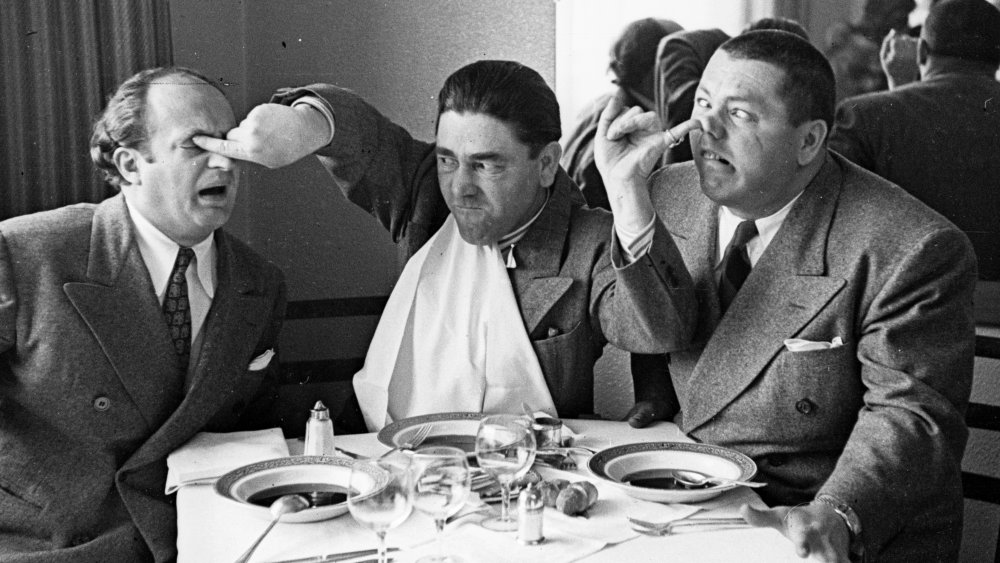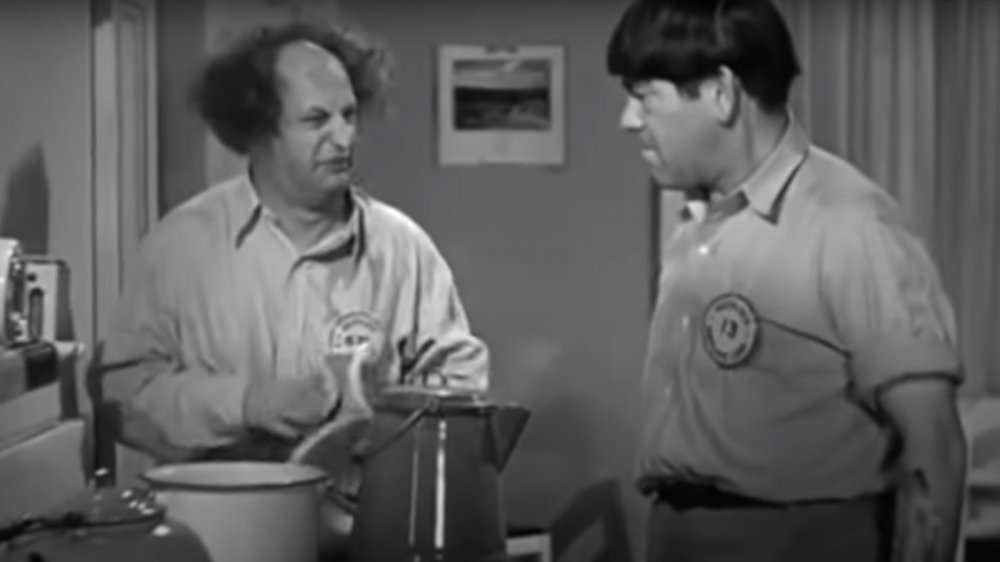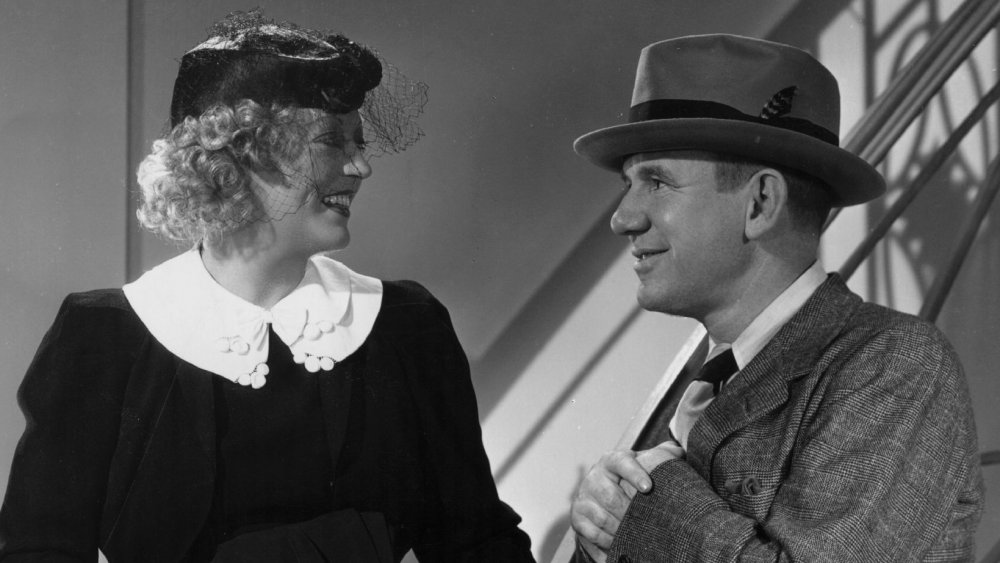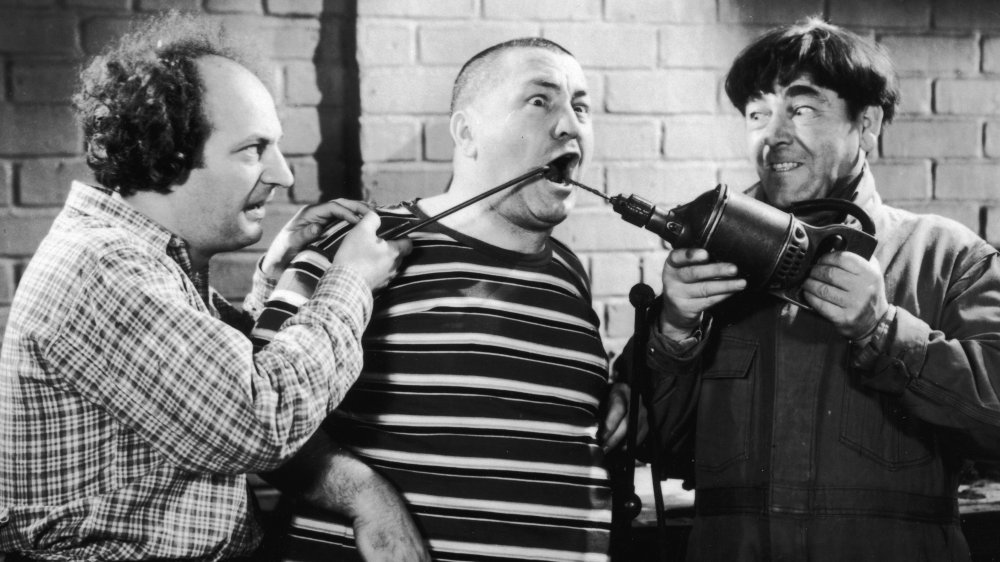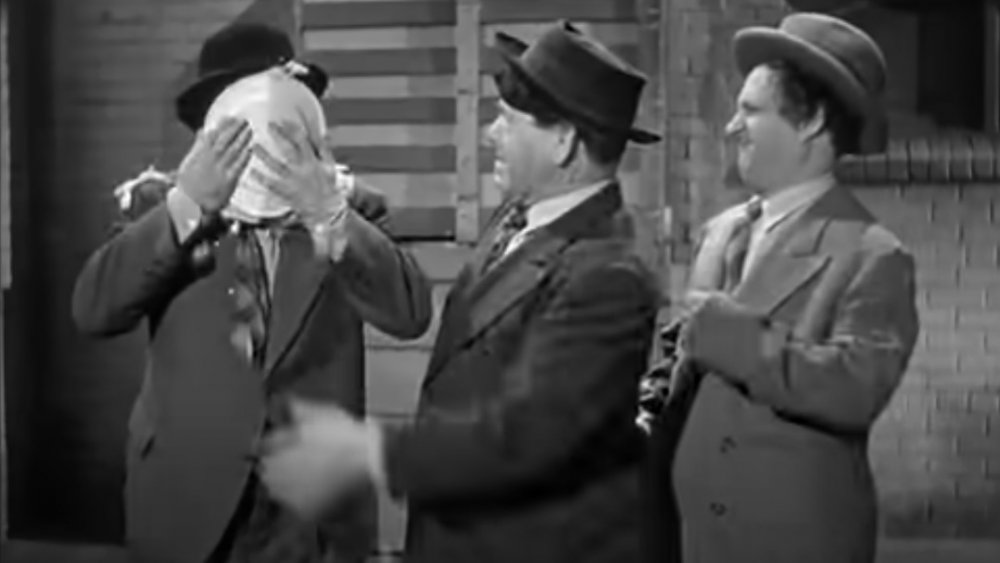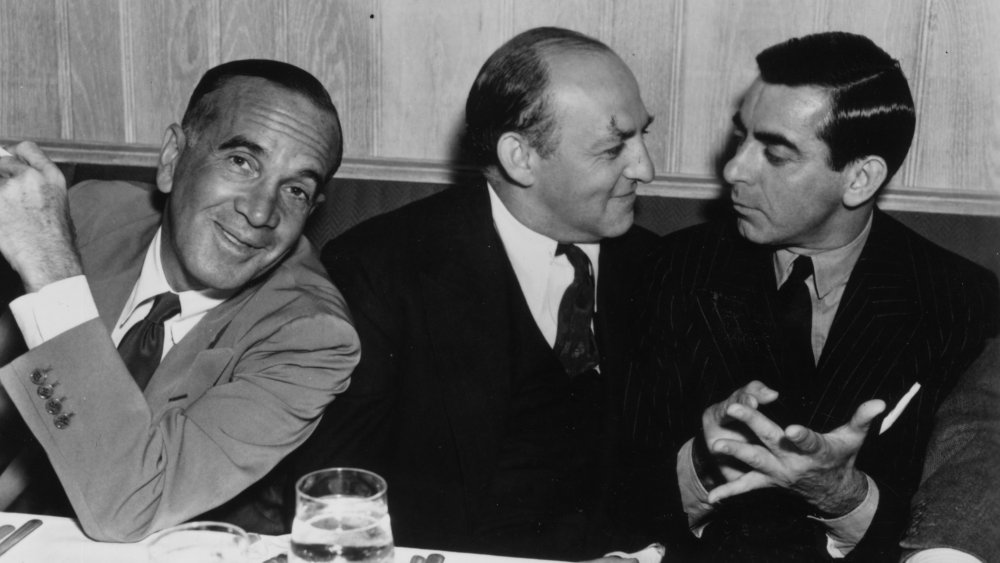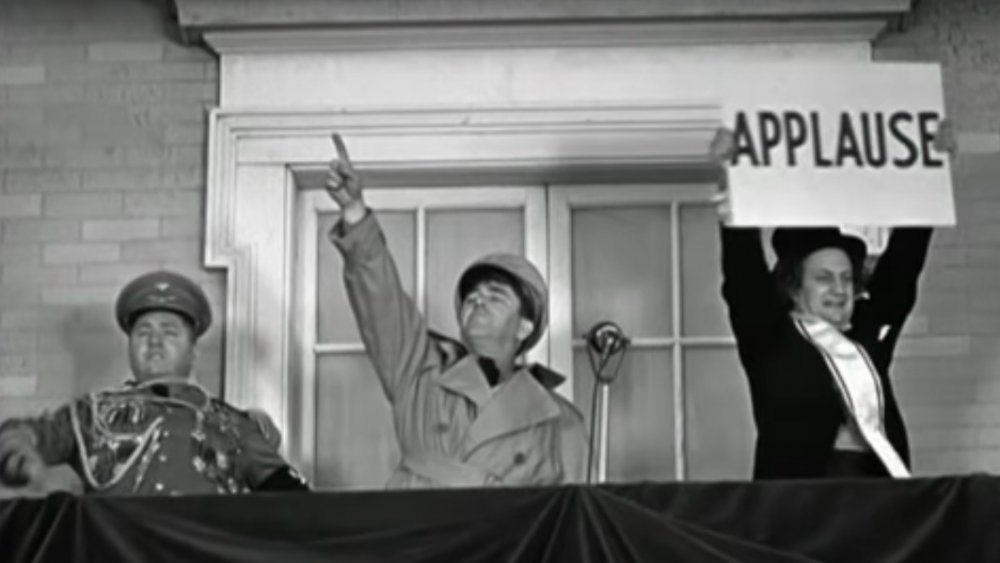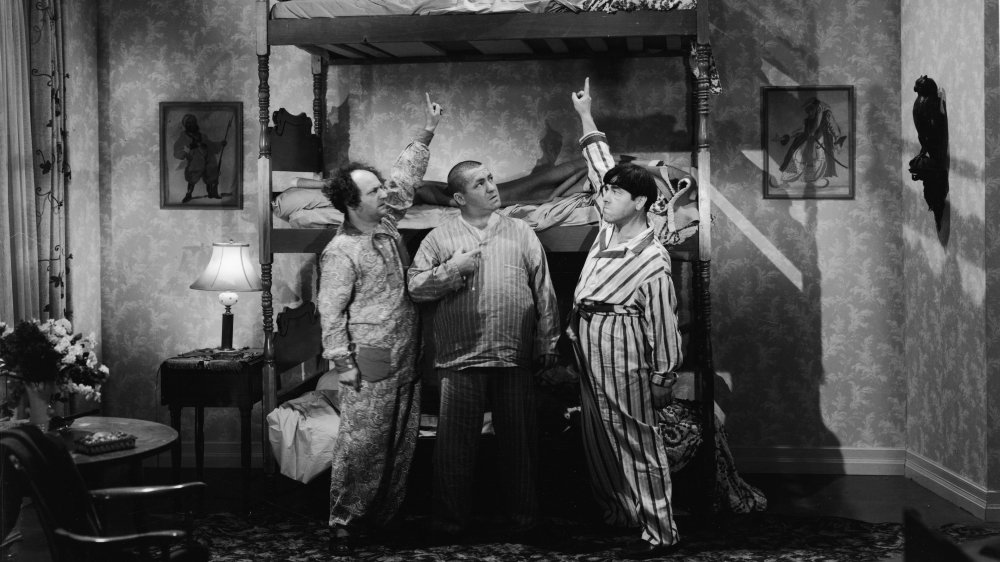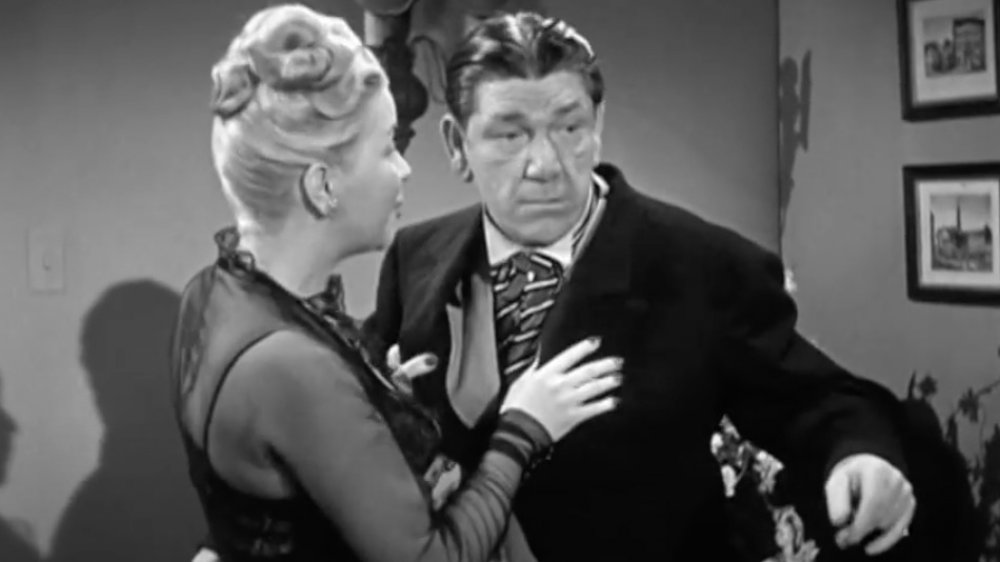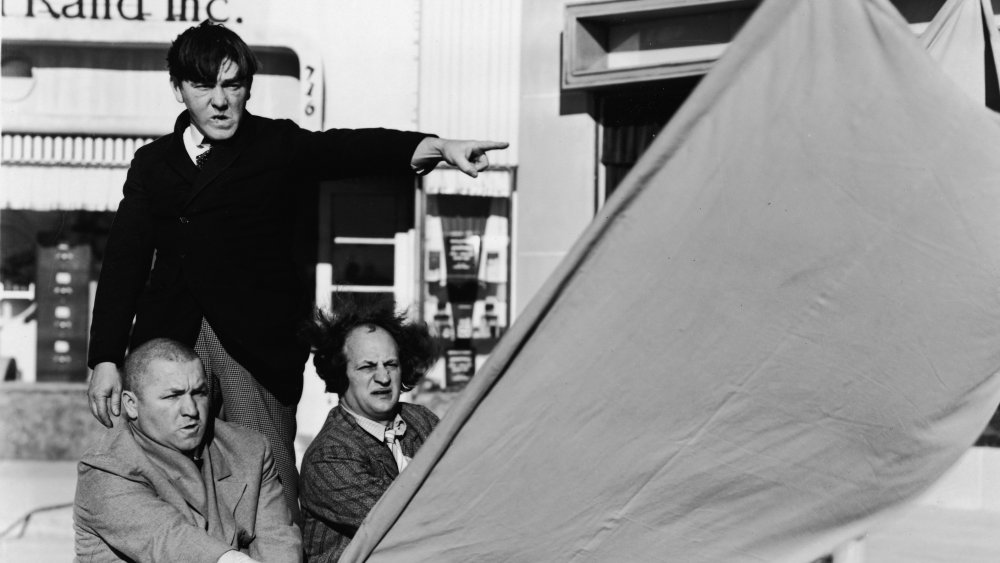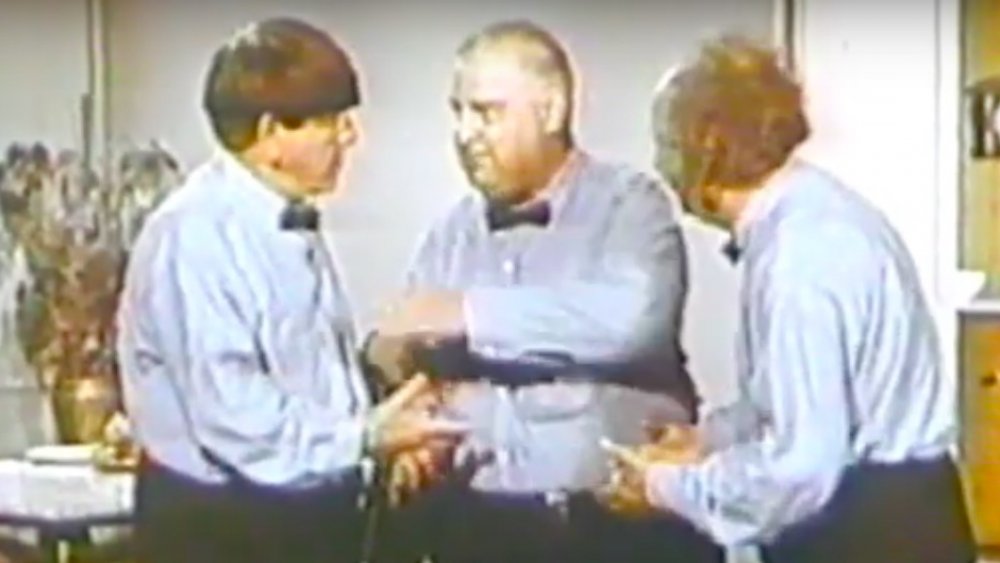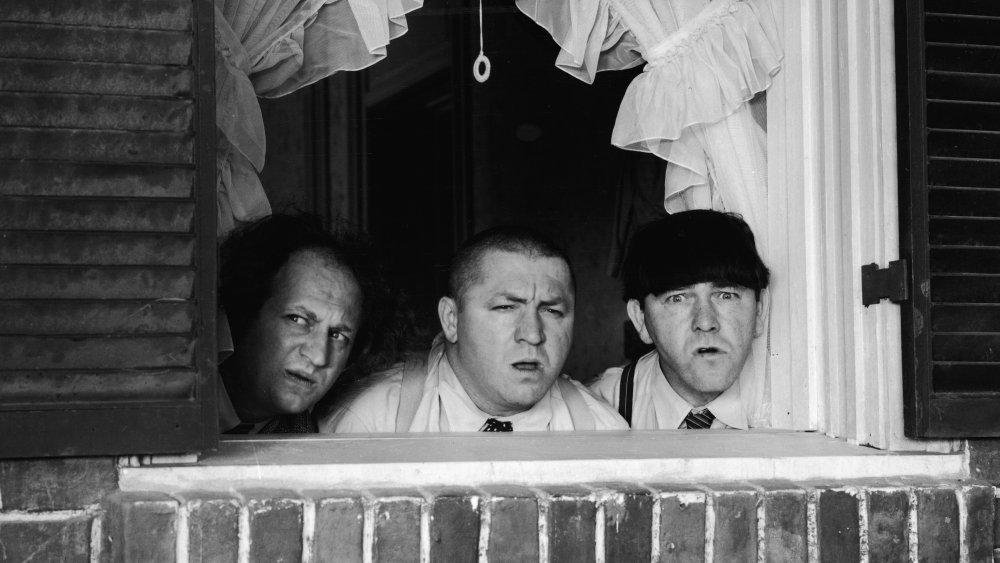The Tragic Real-Life Story Of The Three Stooges
Moe, Larry, and Curly -– born Moses Horwitz, Louis Feinberg, and Jerome Horwitz -– were just a few fellas who grew up in the school of hard knocks. The difference between them and your average knuckleheads? These knuckleheads forever changed television and comedy. But the lives of the Three Stooges were no slice of pie to the face. The real-life stories of Moe (left), Larry (center), and Curly (right) are all riddled with tragedy and hard times.
It all started with a vaudeville act in the 1920s, as stooges (numbskull assistants) to star comedian Ted Healy, according to Empire. By 1934, the Three Stooges (there ended up being six of them over their timeline) impressed Columbia Pictures so much that they were given their own show and went on to star in 200 shorts throughout the '30s, '40s, '50s, and '60s.
If you haven't come across the countless reruns on TV, films about the trio, or callbacks throughout decades of Hollywood, well, the show was nothing fancy. The Stooges would get themselves into calamitous situations, unable to do even the simplest tasks without getting or giving a frying pan to the nose, a pie in the face, or a two-fingered poke to the eyeballs. But the act was perfect in its simplicity and their legacy stands the test of time, inspiring the likes of Jim Carrey, Adam Sandler, Steve Martin, Chevy Chase, and many more, according to the New York Times. Here's the tragic story of the Three Stooges.
Moe was a high school dropout
Moses Horwitz, later known as Moe Howard, was the group's fearless leader and head Stooge. He was born in a small Jewish community outside Brooklyn, per his official Stooges bio, and was the second youngest of five brothers. According to The Three Stooges Scrapbook, Moe (he liked to call himself Harry when he was younger) had shoulder-length hair but was ruthlessly picked on for it. So one day he decided to give his locks a big chop. The result was the famous bowl cut he became known for, long before The Beatles made it cool.
Moe survived the bullying at grade school, but dropped out of high school after just two months –- he was far more interested in something else. Moe would stand outside the theater waiting for someone to buy him a 10-cent ticket. When he'd get in, he'd stand at the top of the balcony through all the acts, chin on the railing, dreaming about becoming an actor one day.
Moe hustled at the theater in Brooklyn, running errands and doing odd jobs until he got his own gig performing in blackface (not uncommon among Jews at the time, per the Times of Israel) at minstrel shows along the Mississippi River. In 1922, Moe and his brother Samuel, aka Shemp, linked up with Ted Healy and brought their boyhood jostling to the vaudeville stage as violent stooges to the star's straight man bit.
Larry Fine could take a punch
Little Louis Feinberg, born to Russian Jewish parents in Philadelphia, was playing with his father's jewelry tools one day and thought he saw a refreshing cool drink. It was actually a bottle of acid used to check the authenticity of gold. According to Offscreen, Louis picked it up to take a sip, but his father slapped the bottle away, burning the boy's forearm in the process. The boy who later became known as Larry Fine needed a skin graft for the burn on his arm and his doctors had him take up violin lessons as a way to strengthen it. Larry took to the violin unbelievably well and ended up playing professionally. He also became a lightweight boxer, fighting for cash, per The Three Stooges Scrapbook.
In 1925, Larry was playing a musical comedy act in Chicago when he came across Ted Healy. Healy happened to be playing the same venue and got a look at Larry's show. Larry's bit was good, so good that Ted invited him to become one of his stooges, joining Moe and Moe's brother, Shemp. What formed was a lasting friendship between Moe and Larry that lasted the next half-century.
Ted Healy was nobody's stooge
While not technically a member of the Three Stooges, Ted Healy gave them their start, so his story is worth mentioning here. Besides, Healy is too tragic and salacious a character not to discuss.
Born in Texas, Healy was a talented comedian, actor, and vaudeville performer who had a successful career –- he even influenced legendary comedian Bob Hope, according to Empire. But Healy was a mean drunk. His on-stage act of verbally or physically assaulting his stooges wasn't too far from the real-life truth. Shemp was so sick of Healy's drunkenness that he quit and went out on his own. When the stooges were offered a contract that didn't include Healy, the former star allegedly completely lost it, threatening to bomb theaters showing the Three Stooges, although this is disputed in Healy's biography Nobody's Stooge.
Three years later, Healy was doing fine without the Three Stooges. His new film The Hollywood Hotel had a successful premiere, and he went out that night for some drinks at the Trocadero night club in Los Angeles. Shortly thereafter, Healy wound up in his hotel room, beaten to a pulp. The next morning, he was dead.
Albert "Cubby" Broccoli, a filmmaker connected to the infamous mobster Lucky Luciano, admitted to getting in a fight outside the Trocadero with Healy that night. Precisely what happened and whether Healy was murdered remains a mystery, but his influence on the Three Stooges remains a lasting part of their legacy.
Curly was one of a kind
When Shemp left, Moe's brother Jerome was brought in to try out. The thing was, like a ripped Carrot Top, Jerome didn't look funny. Jerome, who went by Jerry, had brownish-red hair and a handlebar mustache, and Healy didn't think people would laugh at him. It didn't help that his own brother thought he had "no talent whatsoever," according to Empire.
But Jerry was determined and shaved his head bald right in front of the guys. "Boy do I look Girly," Jerome commented aloud, according to the Argus Leader. Healy thought he heard Curly and the name stuck.
Silly and lovable with his "nyuck-nyuck-nyucks" and his "soitenlys," Curly went on to become almost everybody's favorite stooge. According to the Orlando Sentinel, his on-the-ground shoulder spinning may have inspired breakdancing, and his backward Curly shuffle bounce walk may have partly inspired Michael Jackson's moonwalk.
The Three Stooges got injured by their own stunts
It would be miraculous if after all those hits, jabs, pokes, thumps, flops, and slaps the Three Stooges didn't come away with some serious injuries. According to Moe, miracles ... didn't happen. The head Stooge wrote in his autobiography I Stooged to Conquer that he often got hurt during filming and once broke three ribs. "As rough a character as I seemed to be in pictures, and as tough as I came across, I was hurt in our films more often than either Larry or Curly or any other member of the cast," he wrote.
Moe also wrote that the origin of the Three Stooges' violence stems from a live performance in the Ted Healy days. It was at a 1925 show in Brooklyn that Moe told Healy his brother Shemp was in the audience. Healy called Shemp to the stage and he wouldn't drop the pear he was eating. While on stage, Shemp offered the pear to Healy, but he refused, grabbing it and smashing it over the newcomer's head. This became a recurring bit, and Shemp became part of the team.
Oh, and you know Moe's famous two-fingered eye poke? That was also thanks to Shemp. According to Empire, the guys were playing cards, and when Shemp suspected Larry of cheating he jumped up and poked him in both eyes. Moe thought the whole thing was hilarious, so he worked it into the act.
Columbia Pictures took advantage of the Three Stooges
Harry Cohn, the head of Columbia Pictures at the time, was somewhat of a monarch. In fact, he modeled his office after that of Italian dictator Benito Mussolini, according to the Chicago Tribune. Cohn maintained his tyrannical rep by the awful way he treated the Three Stooges.
After signing them in 1934, Cohn had the trio sign new contracts every year, convincing them that the shorts department was on its last legs. That was only half true. Over the years, shorts were slowly going the way of the dodo bird as television and films took over, but Columbia wouldn't close its shorts department for decades. In the meantime, the Three Stooges were making the studio big bucks. While Columbia was only paying each of the Three Stooges a maximum of $20,000 per year, the studio was raking it in and the Stooges never saw viewership numbers, according to the New York Times. In other words, they had no idea how popular they really were.
To make matters worse, the Three Stooges' manager, Harry Romm, was ripping them off. Romm had "a cozy relationship" with Cohn, said Moe's daughter, Joan Hoard Maurer. Maurer told the Times that her dad grew up poor and didn't know how to fight for what he and the Three Stooges were worth. ”My Dad was fearful. He didn't want to rock the boat. He didn't have the confidence to sit down with Harry Cohn and say, 'We need more money.'"
The Three Stooges fought fascism from home
Like the Marx Brothers before them and Woody Allen or Larry David later on, the Three Stooges' brand of comedy was inspired by an eastern-European Yiddish archetype: the schlemiel, the schlimazel, and the persecutor, according to Faye Ringel's essay in Stoogeology: Essays on the Three Stooges. In the case of the Three Stooges, Curly is the schlemiel -– stupid, childish, and clumsy. Larry is the schlimazel because he's not quite as stupid but still ends up in unlucky situations. Moe is the persecutor because of how abusive he was to the rest of the gang, even though he was just as stupid.
Why is all this important? Because the Three Stooges were Jews, of course, part of a long tradition of Jewish comedy. And while the three Jews never explicitly drew attention to their culture or tradition in their act -– save for the odd Yiddish phrase or two -– they made two important exceptions. While Adolf Hitler was carrying out the Holocaust, the Three Stooges made You Nazty Spy! in 1940, starring Moe as Moe Hailstone, a goofy imitation of Hitler. This was the first film to be released of an American comedian imitating the German chancellor, although Charlie Chaplin's The Great Dictator was in production first, according to the Three Stooges' official page. A year later, the Three Stooges came out with the sequel I'll Never Heil Again, forever influencing the world of political satire in America.
Curly's tragic death
Everybody loved Curly, how could you not? But he struggled in his personal life. Curly was known for reckless partying, hardcore drinking, and would fall for women who weren't good for him, according to Empire. All those hits to the head during the show didn't help either.
By the mid-1940s, Curly's health was visibly declining. He wasn't getting his lines right, he lost weight, and he didn't look healthy. Moe asked Harry Cohn to give Curly some time off to recover, but the Columbia boss wouldn't allow it. According to Mental Floss, in 1945 Curly married Marion Buxbaum after just two weeks of knowing her. Unsurprisingly, the relationship ended in another failed marriage for Curly, who would be married four times. While on set in 1946, Curly had a brutal stroke.
He finally had time to recover, and in 1947 he appeared in the Three Stooges short Hold That Lion!, his last film. It was the only time the three Howard brothers –- Moe, Shemp, and Curly -– were in a short together.
Curly's health continued to seriously decline as he had more strokes. Moe took it upon himself to be his brother's caretaker. On January 18, 1952, Curly died at the tragically young age of 48. Jules White, a director on several Three Stooges shorts, recalled some of Curly's last words: "Gee Jules, I guess I'll never be able to make the children laugh again."
Shemp's triumphant, but short-lived return to the Three Stooges
While the Three Stooges took off into stardom, original Stooge Shemp Horwitz was off doing his own thing after the fallout with Ted Healy. And he was doing well and happy on his own. But when his brother Curly died, Moe pleaded with him to rejoin the Three Stooges. Apart from convincing Shemp, Moe had to convince Columbia to bring him on considering he was a different brand of comedy than Curly, according to Offscreen. Columbia and Shemp eventually agreed to a deal, although Shemp had to forgo half of his paycheck to do so.
Shemp's return was successful, albeit short-lived. On November 22, 1955, Shemp was in a taxi on his way home from a boxing match. As recalled in The Three Stooges Scrapbook, Shemp was in the middle of a joke, smoking a Havana cigar, when he teetered over and fell onto his buddy Al Winston's lap. He'd had a heart attack and died at the age of 60, just three years after his brother Curly.
Columbia abruptly laid off the Three Stooges
Like the misogynistic cigarette-smoking ad execs of Mad Men, by the end of the 1950s, Columbia Pictures needed to adapt or die. In 1957, the studio was the only one in town that still had a shorts department and decided to close it as the winds of television and longer films were sweeping through, according to Empire. With the closure of the shorts department came the decision to let the Three Stooges go after 23 years of blood, sweat, and tears. That's right, they just laid them off without so much as a thank you or tribute.
If that didn't sting enough, think about how Moe must have felt when he got back to the office to say goodbye to his colleagues and security guards blocked him from entering. Complete and total disrespect from Columbia, but that wasn't the last we'd hear from Moe.
The Three Stooges made one final comeback
After the break from Columbia, the Three Stooges found new ways to stay on the air. Columbia syndicated shorts to local and national television, which not only put money in the remaining Stooges' pockets but also made their new material more popular. New fans emerged and the Three Stooges started to cash in on merchandising, according to the New York Times.
But there was just one problem: Who could replace Curly? A couple of Joes — Joe Besser and Curly Joe DeRita — ended up filling the role, but no one would say they stacked up in any way to the Horwitz/Howard brothers. Still, in the 1960s the Three Stooges managed to churn out feature-length films, 41 live wraparound segments and a cartoon series, according to Empire. In 1969, they started shooting a pilot for a proposed TV show called Kook's Tour, which would be a travel show in the vein of the Three Stooges. However, a tragic event in 1970 meant no footage for the travelogue was ever taken.
The Three Stooges' tragic curtain call
Larry had a hard personal life as well. He squandered a lot of his dough on gambling, which meant he and his family lived in and out of hotels up until the 1940s, according to Jewish Virtual Library. In 1961, Larry's son John died in a car crash at the age of 24, according to the book One Fine Stooge. Six years later, Mabel, the love of Larry's life who had stayed with him through it all, died as well. Larry heard the news just before he was to take the stage for a gig in Rhode Island and the guys covered for him when he was too distraught to go on.
In 1970, when the Three Stooges were in the midst of planning Kook's Tour, Larry had a stroke that paralyzed the left side of his body and put him in a wheelchair. Five years later, he had another stroke and died at the age of 73, according to his obituary in the New York Times.
Meanwhile, Moe was still trying to keep the Three Stooges alive. Even after Larry died, Moe signed longtime Stooge costar Emil Sitka to a deal, but it wasn't meant to be. Three weeks after Larry died, Moe succumbed to lung cancer, according to his obituary in the New York Times. And with that came the end to one of the most fascinating and influential acts to ever grace American screens.
